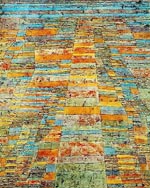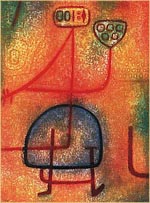
Made
money
How did we make money? One of these part-time directors was a
colleague of mine a chemical physicist, Harden McConnell. At that time
he was working on stable free radicals. Free radicals are chemical compounds
that have a very short life, a matter of seconds or less. He was working
on compounds that in fact had the characteristics of free radicals, but
that could be around, stable, for hours, days, and months. And he was
trying to use this for diagnostic purposes using a technique from physics,
electron spin resonance. It turns out that one of the companies that were
working with us and supporting us were Varian, the manufacturers of electron
spin resonance instruments. So they were obviously interested.
Serendipity
We were just talking at one of our lunches about possible analytic applications;
and the then head of the Stanford Pharmacology Department, Avram Goldstein,
suddenly said: why not use it to determine opioids in urine? This was
the 1960's. It was the time of the Viet Nam war. And testing for opioids
was addressing a real problem. Many soldiers were addicts. Well we developed
a urine test, and overnight we had a 2 million dollar order. The army,
the defence department bought the materials and shipped them over to Viet
Nam where it became the method of choice. Syva developed into a very interesting
chemical diagnostic company. We found that many other chemicals could
be detected in this way, which was useful for example for the treatment
of epilepsy, where therapies for individuals could be tailor-made. That
is only one example. We started with superconductors and ended up with
a chemical diagnostic company and when that company reached 100 million
dollars sales volume, it was acquired by Syntex and became its diagnostic
arm.
More success
A success story. And you could never have predicted that. Except you create
the right environment for the right people. Preferably an interdisciplinary
one
Shebang: You talk about having interdisciplinary
discussions, and yet we haven't properly talked about an entire area of
your life. First of all you have been acquiring art for years. You have
an incredible collection of art. When did that start? Also, bringing your
art interest up to date, you are now working a huge amount of time as
an artist, a novelist and playwright.
Djerassi: Yes. Yes. Initially, you collect art because you want
to want something on the walls, I mean -
Shebang: Come on, you really do know about -
Djerassi: Well, O.K. - I became a serious collector in the 1960's
when I'd actually made some money. And I made this money out of the work
at Syntex. Not that I got royalties from the oral contraceptive patent
because - people thought that I did, but of course I didn't because I
was working full time for Syntex. And so although I am the holder of the
patent it was of course legally assigned to the company, as indeed is
appropriate, that is how it always works. But on the other hand I not
only had stock options, I also bought quite a bit of the stock at that
time in the company, when everyone else said I was a fool, but I believed
in the company and they did not. And Syntex was one of the great success
stories of that period. In the end, it multiplied probably 2,000 times,
over a number of years. If you bought your stock early enough and kept
it long enough, you did all right. And I did all right.
Art
And that's when I started collecting art seriously. Among those works
there were many by an artist who is perhaps my favourite, Paul Klee.
I have a significant Paul Klee collection and I continue to collect Klee.
And all of that is going to the San Franciso Museum of Modern Art. And
there is a continuing exhibition there, in the Djerassi Gallery in the
Museum. And every six months it is changed. And they know that legally
upon my death it will all pass permanently to them. So I became a collector,
but also I have been a donor.
Shebang: You are not the first scientist to admire
Paul Klee. What do you think it is about him?
Djerassi: : Well for me, having been brought up in Vienna, and
having lived there for the first fourteen years of my life, had its advantages
in that I was exposed to art in general, though not Klee. My childhood
in Vienna of course had its disadvantages, particularly during the Hitler
days. But you lived in a museum. Art was part and parcel of everyday life.
Later, as I grew up, Klee was someone whose work you saw all the time.
You'd even see a Klee in a calendar. You saw him in museums. You saw reproductions.
Bit like me
And it occurred to me very soon, but particularly during the 1950's, that
he was like my own character. He was also an intellectual polygamist,
if you think about it. He was incredibly prolific, he did over 9,000 works.
But he did them in every possible medium. He was also an extraordinarily
fine musician, a violinist. He was a poet. He wrote books. He taught at
the Bauhaus.
Different, and special
He was very different from other artists, people like Picasso. Picasso
developed his work through what critics call his periods, like the rose
period, the blue period, cubism and so on. And he actually did 50,000
works. But the difference is that Klee did many different things at the
same time. If you look at his work while he was at the Bauhaus, just in
the years 1933-4 I have some works, painted 2 or 3 months apart. I actually
have them on the wall next to each other. You would never know that this
was the same artist who produced these two works. You would never believe
it. That is I think extraordinary about him.
Titles
The second thing is that he entitled his works in a way that is distinct
from other painters who may say 'Abstraction', or something like
'Naked Woman'. But Paul Klee had titles that were very complex.
I have one called 'Six nudes, mother and children waiting terrifiedly
for the father's return'. Or 'Two men meet, each supposing the
other to be of higher rank'. Very long and evocative titles There
is one in which he shows two children, and the bare outline of a figure
with hands over their heads. It's called 'If only they knew' Now you are
not going to sell pictures on this basis. Klee is the painter's painter.
Kindred spirit
I very much admire the poet Wallace Stevens. He is regarded as one of
the greatest American poets of the twentieth century. Not everyone outside
America has even heard of him, but he is ranked by many alongside giants
like T.S. Eliot and Ezra Pound. And Wallace Stevens also uses intriguing
and complex titles. 'The Emperor of Ice Cream', 'Peter Quince at the Klavier',
for instance. Well, I recently read that Paul Klee was Wallace Stevens'
favourite painter. He would journey in from Connecticut to see every Klee
exhibition that was put on in New York. The other thing about Paul Klee
is he worked on a very small scale. You always have room for another Klee.
Shebang: There is something that is most important
personally for you, as regards art.
Djerassi: Yes, the biggest tragedy of my life. My daughter was
a very promising artist. She was a painter, a graphic artist. She was
a rather good poet. She did ceramic work. And she committed suicide at
age 28. She and her husband lived on a large ranch near San Francisco
where my son and I also had our houses. So the three of us were living
on the same property- well it is a 1200 acre ranch - so we were maybe
an hour apart in terms of walking distance and had the same view from
a place overlooking the Pacific

